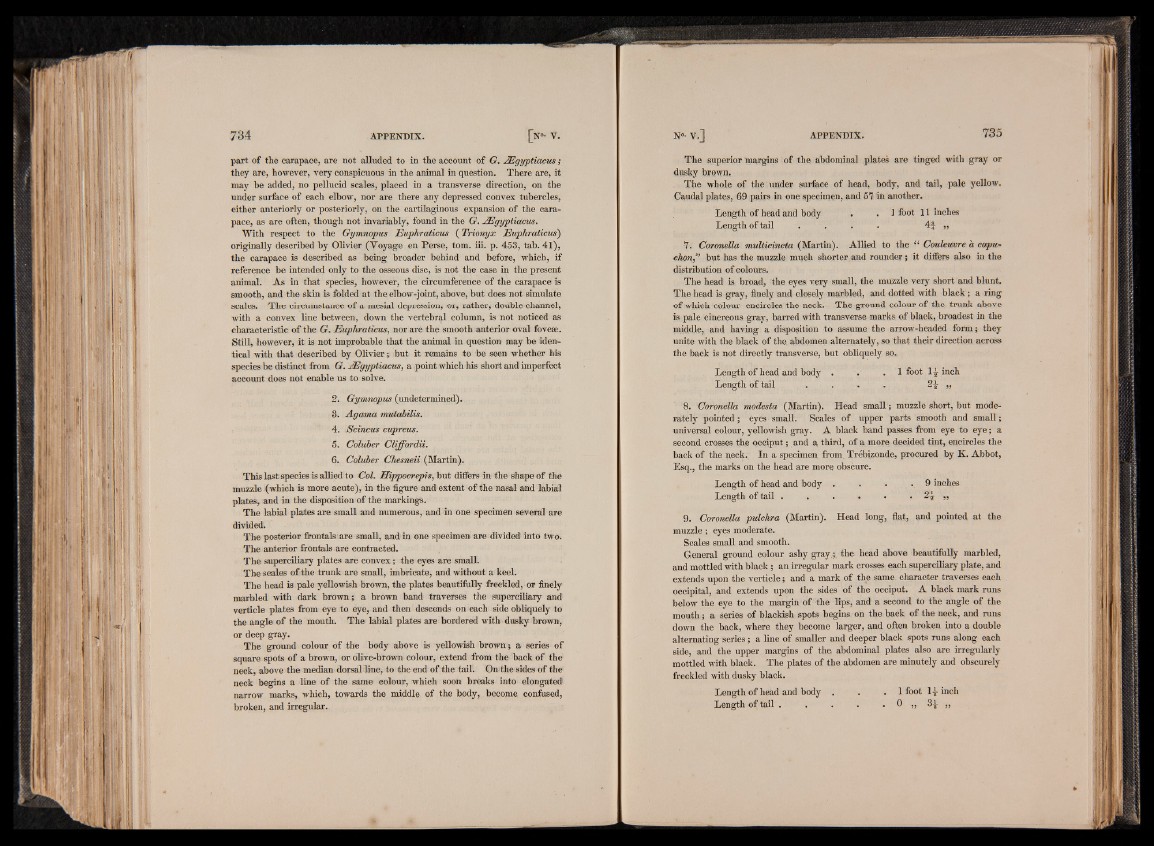
part of the carapace, are not alluded to in the account of G. JEgyptiacus;
they are, however, very conspicuous in the animal in question. There are, it
may be added, no pellucid scales, placed in a transverse direction, on the
under surface of each elbow, nor are there any depressed convex tubercles,
either anteriorly or posteriorly, on the cartilaginous expansion of the carapace,
as are often, though not invariably, found in the G. jEgypticlcus.
With respect to the Gymnopus Euphraticus ( Trionyx Euphraticus')
originally described by Olivier (Voyage en Perse, tom. iii. p. 453, tab. 41),
the carapace is described as being broader behind and before, which, if
reference be intended only to the osseous disc, is not the case in the present
animal. As in that species, however, the circumference of the carapace is
smooth, and the skin is folded at the elbow-joint, above, but does not simulate
scales. The circumstance of a mesial depression, or, rather, double channel,
with a convex line between, down the vertebral column, is not noticed as
characteristic of the G. Euphraticus, nor are the smooth anterior oval foveae.
Still, however, it is not improbable that the animal in question may be identical
with that described by Olivier; but it remains to be seen whether his
species be distinct from G. JEgyptiacus, a point which his short and imperfect
account does not enable us to solve.
2. Gymnopus (undetermined).
3. ALgama mutabilis.
4. Scincus cupreus.
5. Coluber Cliffordii.
6. Coluber Chesneii (Martin).
This last species is allied to Col. Hippocrepis, but differs in the shape of the
muzzle (which is more acute), in the figure and extent of the nasal and labial
plates, and in the disposition of the markings.
The labial plates are small and numerous, and in one specimen several are
divided.
The posterior frontals are small, and in one specimen are divided into two,
The anterior frontals are contracted.
The superciliary plates are convex ; the eyes are small.
The scales of the trunk are small, imbricate, and without a keel.
The head is pale yellowish brown, the plates beautifully freckled, or finely
marbled with dark brown; a brown band traverses the superciliary and
verticle plates from eye to eye, and then descends on each side obliquely to
the angle of the mouth. The labial plates are bordered with dusky brown,
or deep gray.
The ground colour of the body above is yellowish brown ; a series of
square spots of a brown, or olive-brown colour, extend from the back of the
neck, above the median dorsal line, to the end of the tail. On the sides of the
neck begins a line of the same eolour, which soon breaks into elongated1
narrow marks, which, towards the middle of the body, become confused,
broken, and irregular.
The superior margins of the abdominal plates are tinged with gray or
dusky brown.
The whole of the under surface of head, body, and tail, pale yellow.
Caudal plates, 69 pairs in one specimen, and 51 in another.
Length of head and body . . 1 foot 11 inches
Length of tail . . . . 4 f ,,
7. Coronella multicincta (Martin). Allied to the “ Coulewvre a capu-
chon,” but has the muzzle much shorter and rounder; it differs also in the
distribution of colours.
The head is broad, the eyes very small, the muzzle very short and blunt.
The head is gray, finely and closely marbled, and dotted with black; a ring
of which colour encircles the neck. The ground colour of the trunk above
is pale cinereous gray, barred with transverse marks of blaok, broadest in the
middle, and having a disposition to assume the arrow-headed form; they
unite with the black of the abdomen alternately, so that their direction across
the back is not directly transverse, but obliquely so.
Length of head and body . . . 1 foot 1^ inch
Length of tail . . . . 2^- ,,
8. Coronella modesta (Martin). Head small; muzzle short, but moderately
pointed; eyes small. Scales of upper parts smooth and small;
universal colour, yellowish gray. A black band passes from eye to eye; a
second crosses the occiput; and a third, of a more decided tint, encircles the
back of the neck. In a specimen from Trebizonde, procured by K. Abbot,
Esq., the marks on the head are more obscure.
Length of head and body . . . - . 9 inches
Length of tail . . . . • 2^ ,,
9. Coronella pulckra (Martin). Head long, flat, and pointed at the
muzzle ; eyes moderate.
Scales small and smooth.
General ground colour ashy gray.;, the head above beautifully marbled,
and mottled with black; an irregular mark crosses each superciliary plate, and
extends upon the verticle; and a mark of the same character traverses each
occipital, and extends upon the sides of the occiput. A black mark runs
below the eye to the margin of the Kps, and a second to the angle of the
mouth; a series of blackish spots begins on the back of the neck, and runs
down the back, where they become larger, and often broken into a double
alternating series; a line of smaller and deeper black spots runs along each
side, and the upper margins of the abdominal plates also are irregularly
mottled with black. The plates of the abdomen are minutely and obscurely
freckled with dusky black.
Length of head and body . . . 1 foot 1^ inch
Length of tail . . . . . 0 „ 3£ „